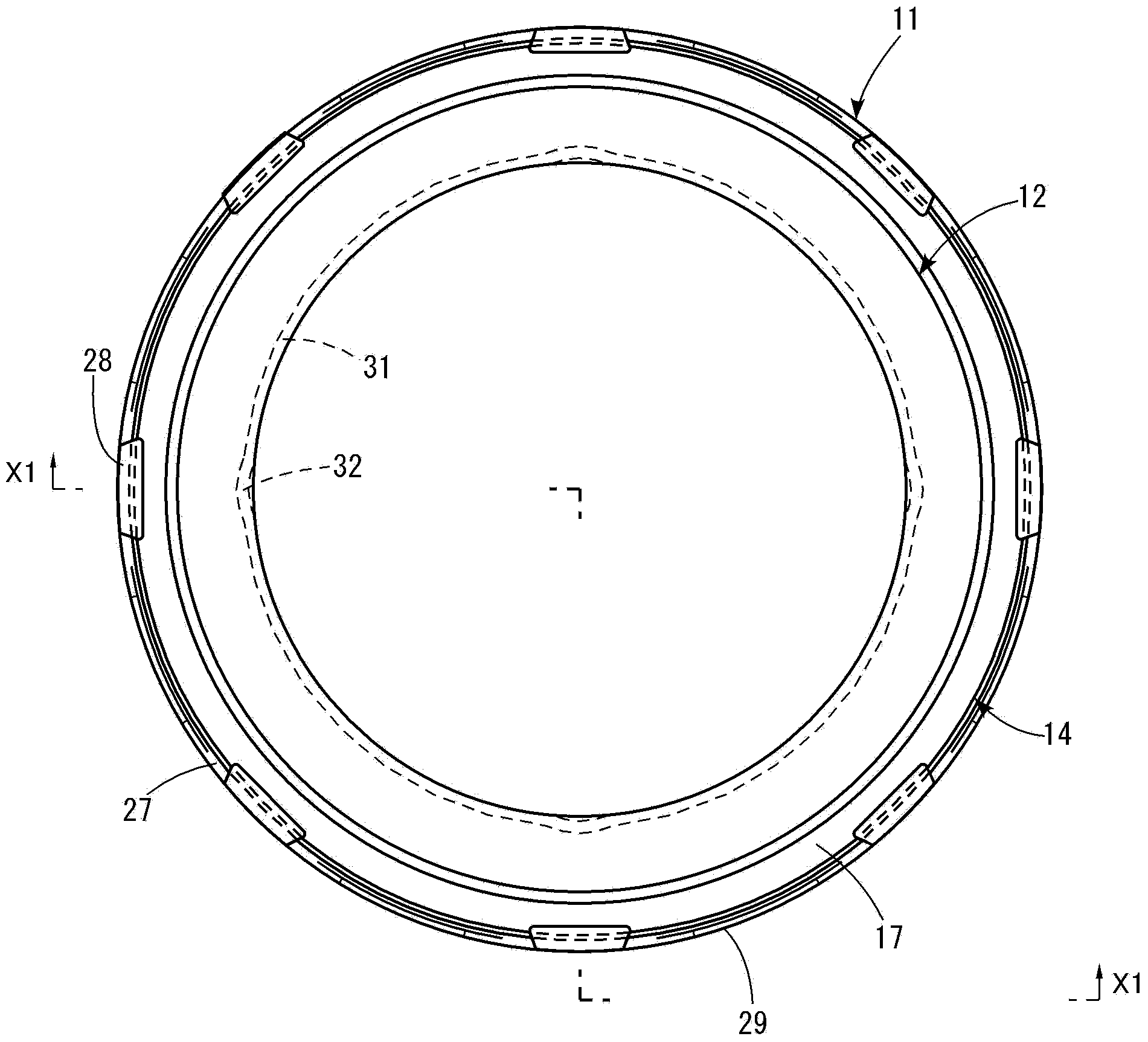Thrust bearing holder and thrust bearing
A thrust bearing and cage technology, applied in the direction of bearings, bearing components, roller bearings, etc., can solve the problem that the cage cannot be applied, and achieve the effect of preventing detachment
- Summary
- Abstract
- Description
- Claims
- Application Information
AI Technical Summary
Problems solved by technology
Method used
Image
Examples
Embodiment approach 1
[0041] Figure 1 to Figure 5 The thrust bearing of Embodiment 1 shown includes an outer ring 11 and an inner ring 12 , a required number of rollers 13 interposed therebetween, and a cage 14 holding the rollers 13 .
[0042] The above-mentioned retainer 14 is formed by piercing a plate-shaped annular member 15 (refer to Figure 4 )form. A main body portion 16 having a constant (constant) thickness is formed in an intermediate portion in the width direction of the annular member 15 . A thin outer peripheral engagement edge 18 is formed on the outer peripheral edge of the main body portion 16 via a stepped portion 17 . In addition, on the surface opposite to the surface on which the above-mentioned outer peripheral engaging edge 18 is formed, a thin inner peripheral engaging edge 20 is formed on the inner peripheral edge via a step portion 19 .
[0043] The outer peripheral engaging edge 18 and the inner peripheral engaging edge 20 are formed by mechanical processing such as p...
Embodiment approach 2
[0054] Figure 12 to Figure 14 The thrust bearing according to the second embodiment shown is basically the same as that of the first embodiment described above, but in this second embodiment, as described above, the width of the outer circumferential engaging edge 18 of the cage 14 is set to be the same as that of the inner circumference. The widths of the circumferential clamping edges 20 are the same, which is suitable for the situation where the internal clearance of the bearing is relatively small. Therefore, since the engagement claw 28a provided on the front end edge of the flange 27 of the outer ring 11 may have a small protrusion amount, it is formed by press-and-recess engagement. The other configurations are the same as in the first embodiment described above.
Embodiment approach 3
[0056] Figure 15 The thrust bearing according to Embodiment 3 shown is composed of a combination of an outer ring 11 and a cage 14 holding rollers 13 . The holder 14 is different from the above-mentioned case in that the outer peripheral engaging edge 18 a formed on the outer peripheral edge of the main body portion 16 is tapered (tapered). Engagement claws 28 a are provided at the front end edge of the flange 27 of the outer ring 11 by press-and-recess engagement, and the outer ring 11 and the cage 14 are integrated with the engagement claws 28 a.
[0057] In addition, when the inner ring 12 is combined, a tapered inner peripheral engaging edge 20 a is formed on the surface of the body portion 16 opposite to the surface on which the outer peripheral engaging edge 18 a is formed.
PUM
 Login to View More
Login to View More Abstract
Description
Claims
Application Information
 Login to View More
Login to View More - R&D
- Intellectual Property
- Life Sciences
- Materials
- Tech Scout
- Unparalleled Data Quality
- Higher Quality Content
- 60% Fewer Hallucinations
Browse by: Latest US Patents, China's latest patents, Technical Efficacy Thesaurus, Application Domain, Technology Topic, Popular Technical Reports.
© 2025 PatSnap. All rights reserved.Legal|Privacy policy|Modern Slavery Act Transparency Statement|Sitemap|About US| Contact US: help@patsnap.com



